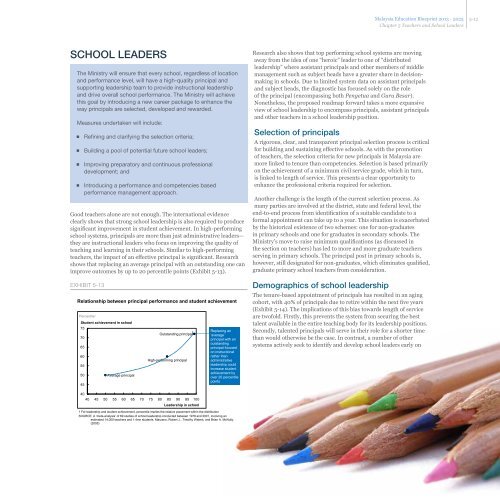Preliminary-Blueprint-Eng
Preliminary-Blueprint-Eng
Preliminary-Blueprint-Eng
Create successful ePaper yourself
Turn your PDF publications into a flip-book with our unique Google optimized e-Paper software.
SCHOOl lEADERS<br />
The Ministry will ensure that every school, regardless of location<br />
and performance level, will have a high-quality principal and<br />
supporting leadership team to provide instructional leadership<br />
and drive overall school performance. The Ministry will achieve<br />
this goal by introducing a new career package to enhance the<br />
way principals are selected, developed and rewarded.<br />
Measures undertaken will include:<br />
▪ Refining and clarifying the selection criteria;<br />
▪ Building a pool of potential future school leaders;<br />
▪ Improving preparatory and continuous professional<br />
development; and<br />
▪ Introducing a performance and competencies based<br />
performance management approach.<br />
Good teachers alone are not enough. The international evidence<br />
clearly shows that strong school leadership is also required to produce<br />
significant improvement in student achievement. In high-performing<br />
school systems, principals are more than just administrative leaders—<br />
they are instructional leaders who focus on improving the quality of<br />
teaching and learning in their schools. Similar to high-performing<br />
teachers, the impact of an effective principal is significant. Research<br />
shows that replacing an average principal with an outstanding one can<br />
improve outcomes by up to 20 percentile points (Exhibit 5-13).<br />
EXHIBIT 5-13<br />
Relationship between principal performance and student achievement<br />
Percentile 1<br />
Student achievement in school<br />
75<br />
70<br />
65<br />
60<br />
55<br />
50<br />
45<br />
Average principal<br />
Outstanding principal<br />
High-performing principal<br />
40<br />
40 45 50 55 60 65 70 75 80 85 90 95 100<br />
Leadership in school<br />
Replacing an<br />
‘average’<br />
principal with an<br />
outstanding<br />
principal focused<br />
on instructional<br />
rather than<br />
administrative<br />
leadership could<br />
increase student<br />
achievement by<br />
over 20 percentile<br />
points<br />
1 For leadership and student achievement, percentile implies the relative placement within the distribution<br />
SOURCE: A ‘meta-analysis’ of 69 studies of school leadership conducted between 1978 and 2001, involving an<br />
estimated 14,000 teachers and 1.4mn students, Marzano, Robert J., Timothy Waters, and Brian A. McNulty<br />
(2005)<br />
Malaysia Education <strong>Blueprint</strong> 2013 - 2025<br />
Chapter 5 Teachers and School Leaders<br />
Research also shows that top performing school systems are moving<br />
away from the idea of one “heroic” leader to one of “distributed<br />
leadership” where assistant principals and other members of middle<br />
management such as subject heads have a greater share in decisionmaking<br />
in schools. Due to limited system data on assistant principals<br />
and subject heads, the diagnostic has focused solely on the role<br />
of the principal (encompassing both Pengetua and Guru Besar).<br />
Nonetheless, the proposed roadmap forward takes a more expansive<br />
view of school leadership to encompass principals, assistant principals<br />
and other teachers in a school leadership position.<br />
Selection of principals<br />
A rigorous, clear, and transparent principal selection process is critical<br />
for building and sustaining effective schools. As with the promotion<br />
of teachers, the selection criteria for new principals in Malaysia are<br />
more linked to tenure than competencies. Selection is based primarily<br />
on the achievement of a minimum civil service grade, which in turn,<br />
is linked to length of service. This presents a clear opportunity to<br />
enhance the professional criteria required for selection.<br />
Another challenge is the length of the current selection process. As<br />
many parties are involved at the district, state and federal level, the<br />
end-to-end process from identification of a suitable candidate to a<br />
formal appointment can take up to a year. This situation is exacerbated<br />
by the historical existence of two schemes: one for non-graduates<br />
in primary schools and one for graduates in secondary schools. The<br />
Ministry’s move to raise minimum qualifications (as discussed in<br />
the section on teachers) has led to more and more graduate teachers<br />
serving in primary schools. The principal post in primary schools is,<br />
however, still designated for non-graduates, which eliminates qualified,<br />
graduate primary school teachers from consideration.<br />
Demographics of school leadership<br />
The tenure-based appointment of principals has resulted in an aging<br />
cohort, with 40% of principals due to retire within the next five years<br />
(Exhibit 5-14). The implications of this bias towards length of service<br />
are twofold. Firstly, this prevents the system from securing the best<br />
talent available in the entire teaching body for its leadership positions.<br />
Secondly, talented principals will serve in their role for a shorter time<br />
than would otherwise be the case. In contrast, a number of other<br />
systems actively seek to identify and develop school leaders early on<br />
5-12


